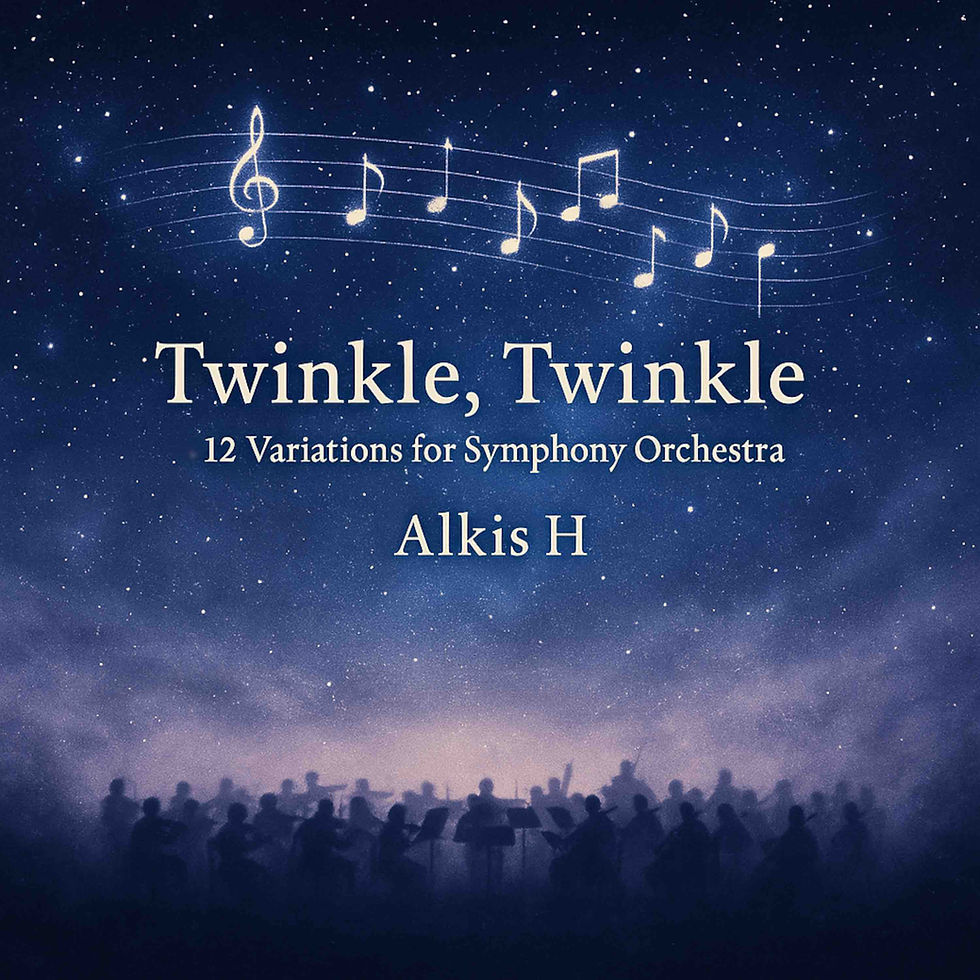Twinkle, Twinkle by Alkis H – 12 Variations for Symphony Orchestra: From Lullaby to Orchestral Epic
- Arashk Azizi

- Jul 31
- 3 min read
Twinkle, Twinkle by Alkis H takes one of the most universally recognized melodies in the world and transforms it into a miniature symphonic journey. This twelve-part work, presented as a continuous arc, retains a steady tempo throughout but evolves dramatically in mood, color, and orchestral texture. What begins as a simple nursery theme grows into something rich, inventive, and at times even grandiose—culminating in a sweeping fugue and finale that feel worlds away from the melody’s humble origins.
About the Theme
The source material for this work is the familiar melody of Twinkle, Twinkle, Little Star—originally a late-18th-century French folk tune titled Ah! vous dirai-je, maman. It’s a short, symmetrical melody that has inspired countless adaptations, from children’s songs to Mozart’s famous 12 Variations for Piano.
In Twinkle, Twinkle by Alkis H, this simple theme serves as a seed for symphonic transformation. Alkis H treats it not just as a melody to be ornamented or harmonized, but as a malleable piece of musical DNA—capable of expressing tenderness, melancholy, grandeur, and even playful absurdity depending on its harmonic and orchestral context. The result is a work that not only honors the theme’s historical significance but also reimagines it for a 21st-century orchestral landscape.
About the Form: Theme and Variations
The theme and variations form, has a long and distinguished history in classical music, from Haydn and Beethoven to Brahms and Rachmaninoff. At its core, the form presents a theme followed by a series of altered versions—“variations”—that explore its potential through changes in harmony, rhythm, instrumentation, style, and mood.
What makes Twinkle, Twinkle by Alkis H stand out is that the variations are defined as much by orchestration as by musical transformation. In many classical examples, variations rely primarily on rhythmic or harmonic development; here, Alkis H frequently uses instrumental color and ensemble combinations to generate variety.
The work opens with Woodwinds: Simple Origins, a transparent presentation of the melody in its most delicate form, followed by Strings’ Grace, a lush string-only setting. The mood darkens in C Minor, before brightening again in Xylophone Dance, which injects playful rhythmic sparkle. The Theme in Song introduces a soft voice, adding a lyrical quality.
Some variations explore stylistic shifts. The Mirror of C leans into post-romantic drama, Sinfonia takes a concerto grosso approach reminiscent of Vivaldi, and Fugue applies baroque counterpoint with bold, almost Beethovenian force. Fragments in Dialogue uses a modernist approach, scattering bits of the theme across instrumental groups in a way that recalls Berlioz’s orchestral experimentation. Otherworldly Echoes toys with the duality of C major and C minor, creating a sense of tonal ambiguity before the final two movements drive toward a decisive, and almost epic, conclusion.
Final Thoughts on Twinkle, Twinkle by Alkis H
By the end of Alkis H’s version of Twinkle, Twinkle, the listener has traveled a remarkable distance from the theme’s innocent opening. This is a full-fledged symphonic exploration of what a simple melody can become when treated with imagination, historical awareness, and orchestral mastery.
From playful dances to dark introspection, from intimate chamber-like textures to grand tutti climaxes, Alkis H uses each variation to reveal a new facet of the theme’s character. The constant tempo becomes a kind of unifying heartbeat, allowing the changing colors and emotions to unfold with clarity.
In an age where so much orchestral music looks backward for inspiration, Twinkle, Twinkle by Alkis H manages to bridge tradition and innovation, proving that even the simplest tune still has untapped worlds to offer. It’s a charming, inventive, and at times thrilling reminder that in the right hands, a familiar melody can still surprise us.
#TwinkleTwinkleByAlkisH #AlkisH #ThemeAndVariations #OrchestralMusic #SymphonicMusic #ClassicalMusic2025 #ModernClassical #ClassicalInnovation #OrchestrationArt #BaroqueInfluence #BeethovianStyle #VivaldiInspired #FugueLovers #OrchestralVariation #ClassicalReview #ContemporaryComposer #OrchestralJourney #ModernSymphony #ClassicalMusicReview #TunitemusicRecommends









Comments